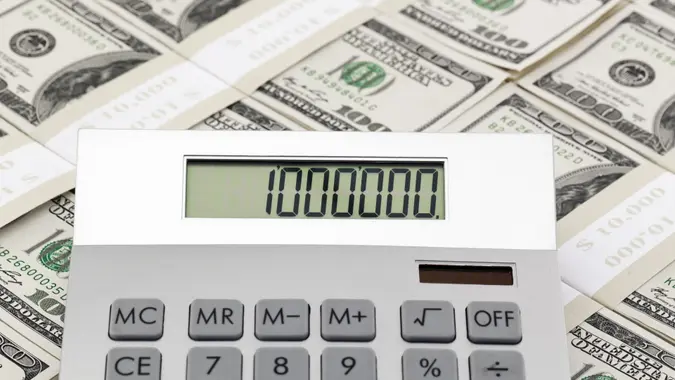Top 6 Signs You’re Not Taking Full Advantage of Employer Matching for Your Retirement

Commitment to Our Readers
GOBankingRates' editorial team is committed to bringing you unbiased reviews and information. We use data-driven methodologies to evaluate financial products and services - our reviews and ratings are not influenced by advertisers. You can read more about our editorial guidelines and our products and services review methodology.

20 Years
Helping You Live Richer

Reviewed
by Experts

Trusted by
Millions of Readers
One of the biggest benefits of a corporate 401(k) plan is the contribution match that many employers offer. While the percentages vary, many employers will match 50% to 100% of an employee’s 401(k) contributions, generally up to a limit of about 5% of an employee’s compensation. So, for example, if you earn $100,000 per year and contribute $5,000 to your 401(k) plan, many employers will kick in an additional $2,500 to $5,000 on your behalf.
This is the closest thing to free money in the investment world, and it pays to take advantage of it. But for any number of reasons, some employees don’t take full advantage of their employer match, leaving free money for retirement on the table. To avoid having that happen to you, here’s a list of signs you could be getting more out of your 401(k) match — and how you can address them.
You Haven’t Checked Your 401(k) Plan Documents
The first and most obvious step to ensure that you’re availing your full employer match is to check your 401(k) plan documents. Your employer is required by law to inform you of its 401(k) matching policy, so your human resources department will have information outlining the process.
Note that employer policies regarding matching contributions can vary considerably, so be sure to check all of the fine print. Generally, you won’t be vested in your employer matching contributions for a number of years, so you’ll have to factor that into your retirement calculations.
You Don’t Contribute at Least the Minimum Required for Matching
Your 401(k) documents will tell you in black and white the maximum amount that your employer will contribute on your behalf every year. In terms of knowing how much you need to kick in to get the maximum possible matching contribution, that’s the most important number to know.
For example, if your employer will match 100% of your contributions up to a limit of 4% of your income, you’ll have to kick in $2,000 if you’re earning $50,000 per year.
You Haven’t Asked About Additional Employer Contribution Benefits
In addition to matching contributions, some employers will make an additional retirement contribution on your behalf, unrelated to the amount that you contribute to your 401(k) plan. While this is not that common, some major employers in the U.S. do offer this employee benefit, so be sure to ask your HR department about it.
You Don’t Understand the Effects of Underutilizing Employer Matching
While an employer 401(k) match might feel like a nice bonus, it’s actually a huge benefit to your retirement account balance. Doing the math will show just how important the employer match is.
Imagine you contribute $5,000 per year to your 401(k) plan for 30 years, earning a 7% annual return. With no employer match, your nest egg will grow to a respectable $508,000. But with a $2,500 annual employer match, your balance will grow closer to $762,000. If your employer matched 100% of your contributions, you’d end up with over $1 million. Not taking advantage of this free money would be a huge financial mistake.
You Haven’t Analyzed the Quality of Your Employer Match
Not all employers are the same when it comes to 401(k) matches. Some offer higher matching percentages than others, some make additional retirement plan contributions, and some don’t offer an employer match at all. As the size of your employer match can make a significant difference to the balance of your future nest egg, it’s worth taking the time to see how your employer stacks up.
In some cases, it may even be worth it to consider working for a different employer, although your 401(k) match should only be evaluated in conjunction with other factors.
You Don’t Contribute More Than the Amount That Your Employer Will Match
It makes mathematical sense to contribute enough to your 401(k) plan to snag the full amount of your employer match. But if you really want to beef up your retirement savings, you shouldn’t stop there.
For 2023, the IRS allows you to contribute the lesser of 100% of your compensation or $22,500 to your 401(k) plan, or $30,000 if you’re 50 or older. Although you won’t get an employer match once you exceed your plan’s limitations, you’ll still enjoy all of the other benefits of a 401(k) plan, including pre-tax contributions and the tax deferral of your gains. Even without an employer match, a 401(k) can be a great way to save for retirement.
Supplement Your 401(k) Savings
Even if you’re taking full advantage of your employer match — and perhaps even contributing the maximum total amount to your 401(k) plan — there are other ways you can boost your retirement savings even more.
One option, as mentioned above, is the “catch-up” provision that the IRS allows individuals age 50 and older. This will allow you to kick in as much as $7,500 more to your 401(k) plan.
If you’re completely maxed out on your 401(k), you can still make nondeductible contributions to an IRA. Contribution limits for 2023 are $6,500, or $7,500 if you’re 50 or older.
Although you don’t likely have a high-deductible health plan if you’re covered by a large employer, if you’re eligible, you can also contribute up to $3,850 to a health savings account if you’re single, or $7,700 if you have family coverage.
Lastly, you can put as much money as you’re able into a regular taxable investment account. You won’t get any tax benefits, but you’ll also be able to access the money whenever you’d like.
More From GOBankingRates
 Written by
Written by  Edited by
Edited by 

























